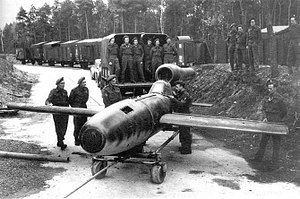Fieseler Fi 103R (Reichenberg)
| Fi 103R Reichenberg | |
|---|---|
 |
|
| Fi 103R Reichenberg (without warhead) captured by British troops in 1945 | |
| Role | Manned missile |
| National origin | Nazi Germany |
| Manufacturer | Fieseler |
| Primary user | Luftwaffe |
| Number built | c.175 |
The Fieseler Fi 103R, code-named Reichenberg, was a late-World War II German manned version of the V-1 flying bomb (more correctly known as the Fieseler Fi 103) produced for attacks in which the pilot was likely to be killed (as with the Japanese Ohka rocket-powered suicide anti-ship missile) or at best to parachute down at the attack site, which were to be carried out by the "Leonidas Squadron", V. Gruppe of the Luftwaffe's Kampfgeschwader 200.
The Leonidas Squadron, part of KG 200, had been set up as a suicide squadron. Volunteers were required to sign a declaration which said, "I hereby voluntarily apply to be enrolled in the suicide group as part of a human glider-bomb. I fully understand that employment in this capacity will entail my own death." Initially, both the Messerschmitt Me 328 and the Fieseler Fi 103 (better known as the V-1 flying bomb) were considered as suitable aircraft, but the Fi 103 was passed over in favour of the Me 328 equipped with a 900 kilograms (2,000 lb) bomb.
However, problems were experienced in converting the Me 328 and Heinrich Himmler wanted to cancel the project. Otto Skorzeny, who had been investigating the possibility of using manned torpedoes against Allied shipping, was briefed by Hitler to revive the project, and he contacted famous test pilot Hanna Reitsch. The Fi 103 was reappraised and since it seemed to offer the pilot a slim chance of surviving, it was adopted for the project.
The project was given the codename "Reichenberg" after the capital of the former Czechoslovakian territory "Reichsgau Sudetenland" (present-day Liberec), while the aircraft themselves were referred to as "Reichenberg-Geräte" (Reichenberg apparatus).
In the summer of 1944 the DFS (German Research Institute for Sailplane Flight) at Ainring took on the task of developing a manned version of the Fi 103, and an example was made ready for testing within days and a production line was established at Dannenberg.
...
Wikipedia
